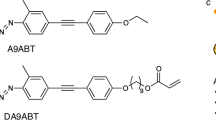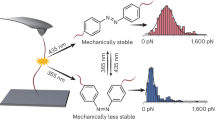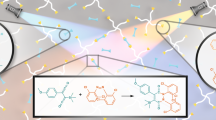Miniaturizing a simple photomechanical system could expand its range of applications.
Abstract
Polymer solutions and solids that contain light-sensitive molecules can undergo photo-contraction, whereby light energy is converted into mechanical energy1,2,3,4,5,6,7,8. Here we show that a single film of a liquid-crystal network containing an azobenzene chromophore can be repeatedly and precisely bent along any chosen direction by using linearly polarized light. This striking photomechanical effect results from a photoselective volume contraction and may be useful in the development of high-speed actuators for microscale or nanoscale applications, for example in microrobots in medicine or optical microtweezers.
This is a preview of subscription content, access via your institution
Access options
Subscribe to this journal
Receive 51 print issues and online access
$199.00 per year
only $3.90 per issue
Buy this article
- Purchase on SpringerLink
- Instant access to full article PDF
Prices may be subject to local taxes which are calculated during checkout

Similar content being viewed by others
References
Van der Veen, G. & Prins, W. Nature Phys. Sci. 230, 70–72 (1971).
Smets, G. & De Blauwe, F. Pure Appl. Chem. 39, 225–238 (1974).
Eisenbach, C. D. Polymer 21, 1175–1179 (1980).
Matejka, L., Ilavsky, M., Dusek, K. & Wichterle, O. Polymer 22, 1511–1515 (1981).
Finkelmann, H., Nishikawa, E., Pereira, G. G. & Warner, M. Phys. Rev. Lett. 87, 015501-1-4 (2001).
Hogan, P. M., Tajbakhsh A. R. & Terentjev, E. M. Phys. Rev. E 65, 041720-1-10 (2002).
Li, M.-H. et al. Adv. Mater. 15, 569–572 (2003).
Ikeda, T., Nakano, M., Yu, Y., Tsutsumi, O. & Kanazawa, A. Adv. Mater. 15, 201–205 (2003).
Ikeda, T. J. Mater. Chem. 13, 2037–2057 (2000).
Ikeda, T., & Tsutsumi, O. Science 268, 1873–1875 (1995).
Author information
Authors and Affiliations
Corresponding author
Ethics declarations
Competing interests
The authors declare no competing financial interests.
Supplementary information
41586_2003_BF425145a_MOESM1_ESM.mov
Supplementary Movie: The polarization direction of 366-nm linearly polarized light (LPL; 3.5 mW/cm2) was set parallel to the long side of the film. When a normal irradiation was performed, the film bent toward the irradiation direction of the incident LPL in 10 s, and the bending direction was along the light polarization. (MOV 1169 kb)
41586_2003_BF425145a_MOESM2_ESM.mov
Supplementary Movie: The polarization direction of 366-nm LPL (3.5 mW/cm2) was anticlockwisely altered by 45 degrees compared with that of LPL in Movie 1, and the bending direction of the film was similarly turned by 45 degrees, still parallel to the light polarization. (MOV 1115 kb)
Rights and permissions
About this article
Cite this article
Yu, Y., Nakano, M. & Ikeda, T. Directed bending of a polymer film by light. Nature 425, 145 (2003). https://doi.org/10.1038/425145a
Issue date:
DOI: https://doi.org/10.1038/425145a
This article is cited by
-
Integrating dual photoresponsive molecules via a cocrystal strategy: photosalient effects, negative photochromism, and fluorescence enhancement
Science China Materials (2024)
-
Light-driven peristaltic pumping by an actuating splay-bend strip
Nature Communications (2023)
-
Polarization-driven reversible actuation in a photo-responsive polymer composite
Nature Communications (2023)
-
Light-driven dandelion-inspired microfliers
Nature Communications (2023)
-
Light- and humidity-driven fluorescence changeable soft robot enabled by water-gated photoinduced electron transfer pathway
Science China Materials (2023)



